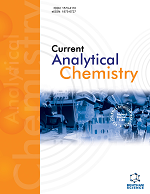- Home
- A-Z Publications
- Current Analytical Chemistry
- Previous Issues
- Volume 4, Issue 2, 2008
Current Analytical Chemistry - Volume 4, Issue 2, 2008
Volume 4, Issue 2, 2008
-
-
Recent Advances in Anthocyanin Analysis and Characterization
More LessAuthors: Cara R. Welch, Qingli Wu and James E. SimonAnthocyanins are a class of polyphenols responsible for the orange, red, purple and blue colors of many fruits, vegetables, grains, flowers and other plants. Consumption of anthocyanins has been linked as protective agents against many chronic diseases and possesses strong antioxidant properties leading to a variety of health benefits. In this review, we examine the advances in the chemical profiling of natural anthocyan Read More
-
-
-
Biomedical Applications of Accelerator Mass Spectrometry
More LessAuthors: Emily L.-C. Cheah and Hwee-Ling KohAccelerator mass spectrometry (AMS) has emerged as an important analytical tool in biomedical and pharmaceutical research. Its sensitivity (up to attomole, 10-18 levels), precision, low sample requirements and the ability to trace a biomarker over a prolonged period of time are valuable attributes. Metabolomic, kinetic, toxicokinetic and dosimetric studies of various chemical molecules, at environmental exposure levels a Read More
-
-
-
Hydromorphone: Analytical Methodologies for its Determination
More LessAuthors: Maansi G. Kumar and Senshang LinHydromorphone, a semi-synthetic derivative of morphine, is being used in the treatment of moderate to severe cancer-related and post-operative pain. It is also one of the most commonly prescribed drug that is often abused. Hence, its detection in biological samples and tissues is important for legal and therapeutic reasons. The purpose of this review is to give a brief description of the various non-chromatographic and chro Read More
-
-
-
Immobilised Metal Affinity Chromatography for the Analysis of Proteins and Peptides
More LessImmobilised metal affinity chromatography (IMAC) has become an established purification procedure for the selective isolation of proteins, peptides and post-translationally modified peptides, using a wide range of metal ions, including Cu(II), Fe(III) and Ga(III). Recently, the potential of interfacing capillary IMAC with mass spectrometry has been explored. This article reviews the development and use of IMAC in protein/peptide anal Read More
-
-
-
Electrochemical Reduction of NAP on the Glassy Carbon Electrodes Modified with Aromatic Diazonium Salts
More LessAuthors: Murat Sadikoglu, Ali O. Solak, Muhammet Isiklan and Zeynel KilicThe electrochemical reduction of 4-{[(1E)-(2-hydroxynaphthyl)methylidene]amino}-1,5-dimethyl-2-phenyl- 2,3-dihydro-1H-pyrazol-3-one (NAP) was studied by using cyclic voltammetry in acetonitrile media at a glassy carbon (GC) and modified GC electrodes. The GC electrodes were grafted by electrochemical reduction of diazonium salts of various organic molecules. GC surfaces modified with anthraquinone, p-nitrophenyl, p-a Read More
-
-
-
Experimental Design Techniques for Optimization of Analytical Methods.Part II: Spectroscopic and Electroanalytical Techniques
More LessAuthors: Federica Bianchi and Maria CareriA review is presented on recent applications of experimental design and optimization techniques for the analysis of compounds of food, biomedical, toxicological and environmental concern. The main features and the significant advantages of chemometric approaches are discussed. Examples related to the determination of substances like xenobiotics, naturally occurring compounds and metals using different analytical techniq Read More
-
-
-
Flow-Injection Chemiluminescence Analysis of Lomefloxacin in Drugs and Biological Fluids
More LessAuthors: Liqing Li, Hanwen Sun and Xueyan ChenA new method was developed for the determination of lomefloxacin by using flow-injection chemiluminescence( CL) based on the reaction of Ce(IV)-sodium thiosulfate-lomefloxacin-sulfuric acid system. The CL conditions were investigated and optimized. The CL intensity was correlated linearly with concentration of lomefloxacin in the range of 1.0x10-5∼6.0x10-2 g L-1. The determination limit (3σ) is 3x10-6 g L-1. The rel Read More
-
-
-
Pressurized Liquid Extraction of Contaminants from Environmental Samples
More LessAuthors: Antonio Nieto, Francesc Borrull, Rosa M. Marce and Eva PocurullThis review updates knowledge on pressurized liquid extraction (PLE), a sample preparation technique that is increasingly used to extract moderately volatile and non-volatile organic pollutants from solid and semi-solid environmental matrices. In environmental analyses, therefore, it is mainly been used to analyse soils and sewage sludge, though it has also been used, albeit to a lesser extent, to analyse air samples. As i Read More
-
Volumes & issues
-
Volume 21 (2025)
-
Volume 20 (2024)
-
Volume 19 (2023)
-
Volume 18 (2022)
-
Volume 17 (2021)
-
Volume 16 (2020)
-
Volume 15 (2019)
-
Volume 14 (2018)
-
Volume 13 (2017)
-
Volume 12 (2016)
-
Volume 11 (2015)
-
Volume 10 (2014)
-
Volume 9 (2013)
-
Volume 8 (2012)
-
Volume 7 (2011)
-
Volume 6 (2010)
-
Volume 5 (2009)
-
Volume 4 (2008)
-
Volume 3 (2007)
-
Volume 2 (2006)
-
Volume 1 (2005)
Most Read This Month
Article
content/journals/cac
Journal
10
5
false
en


